|
80x5 -
240x3 -
240x4 -
320x1 -
320x2 -
320x3 -
640x1 -
640x2
Set display option above.
Click on
images to enlarge. |
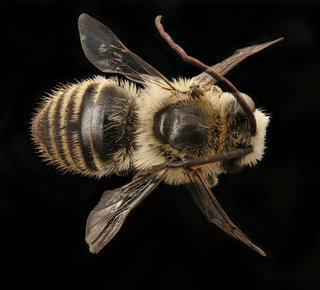
© Copyright source/photographer
· 5
Melissodes manipularis, m, back, sc spring island |
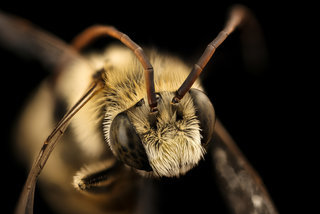
© Copyright source/photographer
· 5
Melissodes manipularis, m, face, spring island, sc |
|
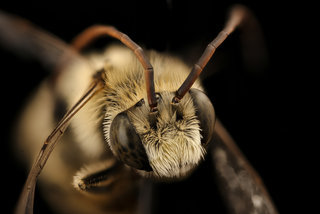
© Copyright source/photographer
· 5
Melissodes manipularis, m, face, spring island, sc |
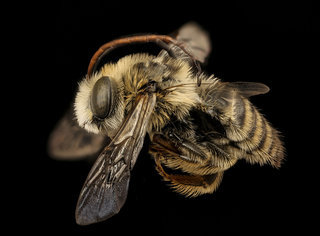
© Copyright source/photographer
· 5
Melissodes manipularis, m, sc, spring island |
|
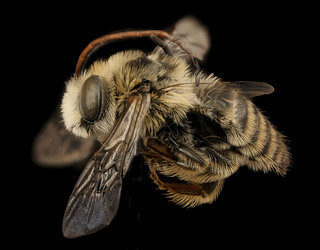
© Copyright source/photographer
· 5
Melissodes manipularis, m, sc, spring island |
|
Overview |
Reprinted with permission from: Mitchell, T.B. 1962 Bees of the Eastern United States. North Carolina Agricultural Experiment Station Technical Bulletin No. 152.
FEMALE—Length 12-13 mm., breadth of abdomen 4.5-5 mm.; black, including labrum and mandibles, the antennal flagella brownish-ferruginous beneath, more piceous above; apical tarsal segments dark, spurs pale yellow; tegulae black; wings subhyaline, veins testaceous to piceous; cheeks considerably narrower than eyes; clypeus only very slightly protuberant, its median length slightly greater than half the distance between eyes below; eyes very slightly convergent below; shorter side of segment 2 of flagellum about half the length of basal segment; punctures of clypeus deep but rather fine, slightly separated, becoming minute and rather densely crowded toward apical margin, those on labrum fine and close medially, becoming slightly separated laterally; supraclypeal area narrowly impunctate along mid-line, becoming rather closely punctate laterally, the lateral areas on each side very finely and rather closely punctate, upper part of face smooth and shining, practically impunctate between eyes and ocelli, median area below ocelli finely but quite distinctly punctate; vertex with very fine, densely crowded punctures behind ocelli, these becoming somewhat more distinct laterally, minute and rather close on cheeks, becoming somewhat more coarse and distinct posteriorly; scutum somewhat shining between rather coarse and deep punctures, these quite sparse over posterior half, becoming rather fine and close laterally and anteriorly, those on scutellum somewhat finer and quite close throughout; pleura rather dull, punctures quite deep and distinct, rather fine and close over lower half, becoming rather abruptly coarser and deeper on upper half; posterior face of propodeum rather dull, punctures fine and quite close but not crowded, dorsal area more coarsely sculptured, becoming rather finely rugoso-striate at each extreme side, lateral faces dull, punctures rather obscure, becoming obsolescent anteriorly and below; basal abdominal tergum quite deeply and distinctly punctate across basal half, punctures quite close but not crowded, becoming somewhat finer and close at each extreme side where they nearly reach apical margin, the broad median apical area entirely impunctate; terga 2 and 3 very finely punctate across basal half, punctures well separated but not sparse medially, becoming rather sparse toward each side on 2, somewhat closer on 3, the apical impressed areas with only exceedingly minute, barely visible, scattered, sparse punctures; tergum 4 very finely and densely punctate across basal half, apical area obscured by pubescence; and basal areas of terga 5 and 6 usually hidden; pygidium rather broadly rounded apically, broadly subtriangular; pubescence of head copious and erect, pale ochraceous to whitish, with a few erect, dark hairs between ocelli and on vertex laterally; posterior half of scutum with a conspicuous patch of erect blackish pubescence, and scutellum black pubescent in large part; thorax otherwise pale ochraceous pubescent; coxae, trochanters and femora largely pale pubescent, the front and mid tibiae each with a dense patch of fuscous pubescence on outer surface toward apex, the basitarsi with considerable fuscous pubescence; hind tibial scopa pale ochraceous, hairs quite densely plumose; basal abdominal tergum with rather short but copious and erect, pale pubescence anteriorly and more narrowly along sides, the disc with some very short, suberect, black pubescence at each extreme side; tergum 2 with a basal fascia that is usually hidden, and a submedian whitish fascia bordering the apical impressed area, sometimes slightly interrupted medially, disc with very short, suberect, dark pubescence, apical area with some similar, very obscure pubescence; tergum 3 with a sub- median white fascia, and that on 4 covering the apical impressed area in large part, the basal areas rather densely black pubescent; terga 5 and 6 entirely black pubescent.
MALE—Length 11 mm., breadth of abdomen 4.5 mm.; black, the labrum yellow medially, clypeus entirely bright yellow; antennal flagellum brownish-testaceous beneath, more piceous above; apical tarsal segments becoming brownish-testaceous, spurs pale yellowish; tegulae dark; wings subhyaline, veins testaceous to piceous; apical margins of abdominal terga becoming somewhat yellowish-hyaline; cheeks slightly narrower than eyes; clypeus only slightly protuberant, its median length very slightly greater than distance between eyes below; eyes somewhat convergent below; basal segment of flagellum extremely short, not much longer than pedicel, segment 2 nearly six times as long as pedicel and segment 1 combined; punctures of clypeus rather fine and obscure, quite close laterally, somewhat separated medially, those on labrum well separated and more distinct; supraclypeal area largely impunctate, the lateral areas of face on each side more finely and closely punctate, upper part of face becoming smooth and shining, punctures very minute laterally, minute in mid-line below ocelli, but rather coarse and deep on each side; vertex with fine densely crowded punctures behind ocelli, these becoming somewhat more distinct laterally, cheeks very minutely punctate along margin of eyes; scutum shining between quite coarse and deep punctures, these quite sparse medially toward the posterior margin, becoming much closer laterally and over anterior half, those on scutellum nearly as coarse but very close, almost contiguous; pleura quite deeply, distinctly and closely punctate throughout; posterior face of propodeum rather finely and closely punctate, dorsal area narrowly impunctate medially, becoming quite coarsely rugoso-punctate on each side, lateral faces dull and rather closely punctate throughout; basal abdominal tergum quite coarsely, deeply and closely punctate, the punctures somewhat more sparse medially, becoming minute toward the narrowly impunctate apical margin; tergum 2 deeply and distinctly but finely and quite closely punctate across basal half, the apical impressed area with only very obscure, minute punctures in evidence; tergum 3 more minutely and rather closely punctate across base; terga 4 and 5 very closely punctate; apical impressed areas of all largely impunctate; tergum 5 with an obscure apical angle on each extreme side, and 6 with a corresponding, triangular, apical spine; pubescence of head copious and erect, entirely pale ochraceous; scutum with a median posterior black pubescent patch, and scutellum quite largely covered with blackish pubescence, thorax otherwise with copious, erect, ochraceous pubescence, that of legs entirely pale; basal abdominal tergum with copious, erect, pale ochraceous pubescence basally and along lateral margins, disc with some suberect black pubescence on each side toward apical margin; tergum 2 with a whitish, rather dense, basal fascia, and a submedian, rather broad fascia that borders the apical impressed area, intermediate area with short, suberect but rather conspicuous, blackish pubescence and a few suberect black hairs on apical area; tergum 3 with a rather narrow fascia bordering the apical impressed area, and with considerable thin, pale tomentum between it and the base, this covered in part with erect, but rather short black hairs, apical impressed area with some short, more decumbant, dark hairs; tergum 4 with a subapical whitish fascia, basal area with elongate black hairs, and apical margin narrowly bare; terga 5 and 6 entirely black pubescent; median length of pygidial plate considerably less than basal width, lateral margins carinate, strongly convergent apically to the abrupt, subapical constriction, the apex rather broadly truncate; sterna 7 and 8 genital armature resembling those in dentiventris (fig. 84).
DISTRIBUTION — North Carolina to Florida, in September.
FLOWER RECORDS — Chrysopsis and Kuhnistera.
|
|
|
Names | |
|
|
| Supported by | |
Updated: 2024-04-19 01:09:06 gmt
|